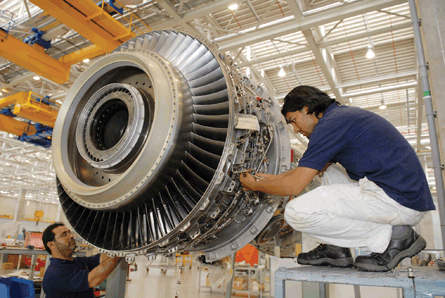Emirates Airline's maintenance organisation plans to build additional hangars within a few years to adapt to the carrier's exponential growth - while striving to maintain a leading edge in cabin interiors.
Such are the demands of the Dubai-based carrier's own fleet that Emirates Engineering's third-party MRO business is limited to line maintenance and some shop-based component support, such as wheel and brake repair and overhaul. Any service beyond that would depend on vacant capacities and would be secondary to the parent airline's needs.
 |
|---|
© Emirates EngineeringEmirates may seek new partnerships as it expands its engine capabilities |
With the capacity limit of its maintenance facility in sight, Emirates Engineering is looking to build further hangars "probably within the next two to three years", says Iain Lachlan, senior vice-president of aircraft maintenance.
This will add to what is already the Middle East's biggest MRO complex, which the company opened at Dubai International airport in 2007. It comprises seven Airbus A380-size maintenance hangars, overhaul shops for engines and components, storage facilities and a staff training centre. The company has also added an engine run-up test pen and, last November, a paint hangar. Four aircraft had received a fresh exterior finish by early January.
ENGINE TEST CENTRE
In 2009, an engine test centre was opened 40km (25 miles) from Dubai International airport. It can test engines with up to 150,000lb thrust (667kN) and has a capacity of 300 engines and auxiliary power units a year.
To extend heavy maintenance capacity, a fifth hangar is to be equipped with a full docking system in the next year. At present, two hangars have docking systems for the A380, a third one can accommodate Boeing 777-300ER and smaller aircraft, and the fourth can handle models up to 777-200 size.
 |
|---|
© Emirates EngineeringEmirates' MRO base has a new paint hangar |
Apart from increasing the facility's size, Emirates aims to create additional capacity by becoming more efficient. Initiatives to reduce waste cover internal and external processes at suppliers and other partners. For example, co-operation with Airbus has helped to reduce the ground time for an A380 C1 check by a certain margin. Emirates has so far undertaken four such checks, with the last one taking 20 days, including "a quite heavy modification programme", says Lachlan.
Asked what expansion plans Emirates Engineering has for Dubai's new Al Maktoum International airport, Lachlan says: "It has not made a decision whether it would ever go to Dubai World Central, as far as I am aware."
| DAE TO SELL STANDARDAERO? StandardAero has neither confirmed nor rejected suggestions that parent Dubai Aerospace Enterprise is planning to sell it following the Gulf emirate's financial woes. "As DAE is an investment company with a diverse group of shareholders and a wide variety of interests, it would not be unusual to look at strategic options and evaluate the possibility of new shareholders and partners," said StandardAero in December. In 2007, DAE acquired StandardAero along with the business aircraft charter and MRO company Landmark Aviation from Carlyle Group for $1.9 billion. |
Maintaining an industry lead in terms of aircraft cabin interior features, in-flight entertainment and connectivity across the airline's fleet is a major demand on top of MRO work. Offering the "latest and greatest" in passenger comfort levels is one of Emirates' central strategies. "There is obviously a challenge in the company to deliver that expectation," says Lachlan. Cabin refurbishment, retrofit and refreshment programmes - as part of C-check work for the 154-strong fleet - keep five hangars permanently occupied, he points out.
Emirates Engineering is continually assessing whether to develop new technical capabilities and avoid outsourcing. One of the latest developments in the engine overhaul shop is the introduction of module replacement for Engine Alliance GP7200 engines.
As long as it leads to added value, this could cover "anything from expanding hydraulic/pneumatic to engine [capabilities]", says Lachlan. The company could either develop these on its own or in conjunction with "interested parties that see an opportunity to expand in the Middle East", he adds.
Source: Flight International



















